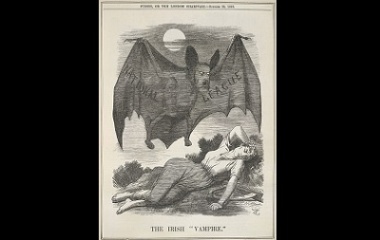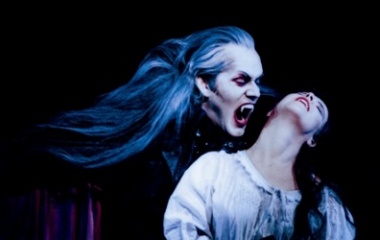What is a Vampire?
Vampires are undead creatures who suck the blood from their sleeping victims. They represent a global infestation, appearing in almost every culture since the dawn of time, so while you would be wise to try to hide from these bloodthirsty villains, you would be hard-pressed to find a safe haven.
Characteristics
Physical Description
Around the world and over centuries, Vampires have been painted in many different styles.
Early, non-European Vampires often appeared as beautiful young women. When need be, these attractive ladies could transform themselves. They might sprout wings, tails, long tongues, or transform into an entirely different creature, like a snake or bird of prey.
Early, European Vampires took a turn for the worse. They were hideous creatures: heavily bloated, with dark pink or purple skin, long hair and fingernails, and blood seeping from their noses and mouths. Even though they moved around at night, they still wore dark shrouds to try to conceal their grotesque shapes.
After the nineteenth century, Vampires circled back to their original, attractive form. Despite being startlingly pale, they are also graceful, strong, and well-groomed. They have flawless skin, with no signs of decomposition. If you look closely, you might notice a pair of fangs poking out from their lips.
Special Abilities
Vampires are classified as “undead” creatures; despite having “died” previously, they can climb from their coffins and wreak havoc on nearby villages. Unlike other undead creatures, many Vampires retain their intelligence, and sometimes even their personality, from their mortal life. They are not mindless, blood-sucking monsters. They plan their actions, and they often target victims who grieved them during their mortal life.
On top of their innate personality and intelligence, many Vampires have a sort of magical charisma. They can be hypnotic, even seductive, dazzling their victims so that they don’t want to fight back against an attack.
Vampires are stronger and swifter than humans, and some of them, especially the ancient, shapeshifting variety, can even fly.
Weaknesses
Because of their lust for blood, Vampires are rarely welcomed into human society. Almost every culture has its own special methods for driving away, or killing, Vampires.
Special herbs and symbols can be used to repel Vampires. Garlic, wild rose, hawthorn, and mustard seeds are common European repellents, while oak, ash, aloe vera, salt, and coconut oil are used in other places. Religious symbols, like holy water or the crucifix might, also ward off Vampires, and the monsters might avoid mirrors, since their lack of a reflection might reveal them as Vampires.
Killing a Vampire is far more difficult than deterring it. Vampire hunters must first locate the grave from which the Vampire rises, then return to the grave by daylight, dig up the body, and mutilate it. Driving a stake through the chest might put a stop to the Vampire’s forays. If not, the body will need to be burned or decapitated.
Vampires around the World
Europe
The Greeks and Romans believed in three shape-shifting, blood-drinking demons: the Empusae, the Lamia, and the stiges. All of them appeared as young women but were capable of changing into animal forms like serpents and crows. The Empusae lured men into their clutches, using their beauty, while the Lamia and stiges preferred to suck their blood from infants.
Meanwhile, the ancient Norse people feared the draugr, an undead creature with a massive, hideous body who guarded tombs full of treasure. If provoked, the draugr could emerge from his stinking caverns and attack villages, feasting on human flesh and blood.
By the 1700s, the “Vampire” was known in Eastern Europe by its modern name. It was grotesque and purely evil—unlike the glamorous, romantic Vampires who are popular in today’s fiction.
Southeast Asia
In Malaysia, horror stories about a blood-sucking creature called the penanggalan are popular. The penanggalan appears as an attractive girl during the day. At night, its head separates from its body and flies off in search of human prey, trailing its spine and internal organs through the sky. It has an appetite for newborn babies, and it uses its long tongue to reach into houses and suck the blood from infants.
In the Philippines, locals live in a dread of a phantom called the aswang. The aswang looks like a normal person during the day, although it’s eyes may be shadowy or show upside reflections of the world. It can act like a normal person too, and it may even have a job—the village butcher or witch-doctor, for instance. At night, the aswang transforms into an animal shape to find prey. They are especially fond of pregnant women and corpses.
Indonesia is haunted by the ghostly kuntilanak, a phantom woman who returns to life after dying during childbirth. These women prey on children or men, who they attract with their beautiful black hair. They have a hole in the back of their necks, which they use to drink blood from their victims. They also have long, sharp fingernails which can tear out eyeballs or internal organs. Stuffing the hole in the back of their necks can return them to their original, human state.
The Americas
In Central America and Louisiana, French folklore and African folklore combined to create voodoo, a culture rife with superstition and ghost stories. It’s no surprise, then, that voodoo culture put its own spin on the vampire. The loogaroo, a hag who dabbles in black magic, takes her skin off each night and flies through the sky as a fireball. When she finds a victim, she sucks blood through the soft parts of his arms and legs, leaving dark bruises behind.
Cultural Representation
History
Legends about the undead have been around for almost as long as death itself. Blood-sucking is not always part of the legend; sometimes the undead eat their victims or infect them with a plague. Still, every ancient culture has some version of a villain rising from its grave, vampire-style, and feasting on mortal humans. It’s impossible to say which one of these vampire-esque creatures came first.
The name “vampire” is much less ancient than the idea. It emerged during the 17th century, with cognates in English, French, German, Bulgarian, Macedonian, Bosnian, Czech, Slovak, and Russian. The name probably caught on because doctors and theologians were beginning to publish papers about various undead conditions, which they called vampirism. Soon, newspapers were blaming strange deaths on Vampires as well.
By the 18th century, Europe had entered a stage of full-fledged, Vampire hysteria. The stealthy, blood-suckers were used to explain epidemics of tuberculosis and mysterious, violent deaths. Digging up graves and mutilating “vampire” corpses was considered acceptable, even heroic. Frightened people began buying religious talismans and magical herbs to try to protect themselves from Vampire attack.
During the 19th century, Vampire-lore finally began to die down. Then, not surprisingly, the legend found a way to rise from its grave. Gothic writers re-invented Vampires in landmark novels like Bram Stoker’s Dracula, which gave us the polished, smooth-talking villain that we know today.
Modern Appearances
More recently, Vampires have found a new literary niche: romance. Writers like Anne Rice and Stephenie Meyer (with the Twilight) saga discovered that Vampires have the ultimate bad-boy appeal and created a whole new subgenre of the romance novel: paranormal romances.
Of course, Vampires will always have a home in horror and thriller stories as well. True Blood, Buffy the Vampire Slayer, and The Vampire Diaries have been hugely successful in using blood-thirsty Vampires and swashbuckling Vampire hunters to captivate their audience.
Explanation
At first, it’s hard to imagine how a sane person could dream up a villain as horrifying as the Vampire—but death itself is horrifying, so horrifying that it could explain many of the myths about Vampires.
The natural decomposition process creates truly monstrous corpses. Water loss causes the skin to shrink, which in turn makes hair, teeth, and fingernails appear to grow. Trapped gases, which are produced by the bacteria feeding on the body, make it appear bloated and discolored. Dark, putrefied bodily fluids can leak through the nose and mouth. An untrained person who saw a corpse in this condition could easily be terrified into thinking that he had found an inhuman monster.
Similarly, many Vampire victims can be explained by modern science. Vampires are often seen targeting pregnant women, who are subject to spontaneous abortion, and infants, who are vulnerable to sudden infant death syndrome (SIDS). Both of these tragedies can strike randomly, leaving the survivors with nothing but their imaginations to explain what happened. Adult Vampire victims are described as having, long, drawn-out deaths; day by day, they grow paler and weaker until, at last, they die. These symptoms match up with several wasting diseases, like tuberculosis or consumption, but before doctors described these diseases, it would be easy to imagine that the life—or blood—was being gradually sucked out of your loved one.
Vampire






No comments:
Post a Comment